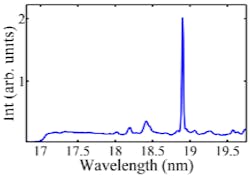CLEO/QELS PREVIEW: CLEO: From terahertz to x-rays
As it does every year, the Conference on Lasers and Electro Optics and Quantum Electronics and Laser Science Conference (CLEO/QELS 2010; May 16–21, 2010; San Jose, CA) will bring together the most exciting and important of the past year's technological achievements in photonics. And this year is a notable one, as it is the 50th anniversary of the invention of the first working laser.
The peer-reviewed CLEO/QELS technical sessions highlight leading-edge research from universities, industry, and independent institutions; CLEO Applications covers components, systems, and emerging applications of lasers and electro-optical technology; and the Market Focus focuses on business development and commercialized applications. In addition, more than 300 companies will exhibit their newest products and innovations.
Showcasing new results, talents
The foundation of CLEO has always been the high quality of its technical sessions, and this year's talks are a balanced mix of theory, simulation, experiment, science, and engineering.
For example, a paper presented by researchers at UMR CNRS (Besançon, France) and Macquarie University (New South Wales, Australia), "Femtosecond Bessel Filaments for High Aspect-Ratio and Taper-Free Micromachining of Dielectrics" (paper 1486), will outline a new approach to laser-machining high-quality sub-10-µm-diameter channels straight down into transparent glass (such channels are essential for lab-on-a-chip and DNA-analysis systems). Femtosecond lasers have previously been used to create hollow channels in glass but only using ordinary diffracting beams, limiting the depth that could be created without a taper. Bessel beams have previously been used for laser machining but not for creating hollow channels in glass. Here, the researchers combine the two approaches to fabricate taper-free channels 80 µm in depth and only 2 µm in diameter.
In the esoteric but rapidly expanding area of quantum optics, scientists from the Austrian Academy of Sciences (Innsbruck and Vienna, Austria), the University of Innsbruck, and the University of Vienna will be discussing their experimental results in "Quantum-Opto-Mechanics in the Strong Coupling Regime" (paper 329). The objective is to successfully have control over the quantum motion of mechanical systems by using radiation pressure in optical cavities. "Strong coupling" allows reversible exchange of energy between the light field and the mechanical system; the researchers have demonstrated just such an effect, and, in the technical session, discuss how such interactions could generate quantum entanglement involving mechanical resonators.
In 2008, researchers from the Max Planck Institute for Quantum Optics (MPQ; Garching, Germany) pioneered research into optical frequency combs using silicon microtoroids that had an experimental precision better than 10-17 and spanned a 550 nm bandwidth around a 1550 nm center wavelength, with frequency spacing on the order of 100 GHz. Optical frequency combs are useful for metrology applications such as atomic clocks. Now, along with researchers at Ecole Polytechnique Fédérale de Lausanne (EPFL; Lausanne, Switzerland), the MPQ group has again used four-wave mixing in a fused silica microtoroid to create a frequency comb; this time, however, the microtoroid is fabricated on a silicon chip, spans a full octave from 990 to 2170 nm with an 850 GHz mode spacing, and, most important, is self-referenced. The research, to be presented in the talk "Octave-Spanning Tunable Frequency Combs on a Chip," will show how increasing the seed laser power leads to expanded bandwidth and how slightly changing its frequency tunes the whole comb by more than one mode spacing, leading to carrier-envelope frequencies in the radio-frequency (RF) range. The researchers say that their work is an important step toward obtaining an RF-to-optical link on a silicon chip, unifying frequency metrology with chip-scale silicon photonics.
A tabletop diode-pumped x-ray laser emits at 18.9 nm.
And in this particularly significant year for the laser, technology that could hardly be imagined 50 years ago is being made practical. A group at Colorado State University (Fort Collins, CO) will describe a "Soft X-Ray Laser Pumped by a Joule-Class, All-Diode-Pumped Laser System" (paper 964). The group has created the first all-diode-pumped soft x-ray laser, which emits at a 18.9 nm wavelength (see figure) and a 10 Hz repetition rate and (except for the vacuum pulse compressor) fits completely on a 5 × 12 ft optical table. Another group, at the Massachusetts Institute of Technology (Cambridge, MA) and Sandia National Laboratories (Albuquerque, NM), is working at a much different point in the electromagnetic spectrum–the terahertz region. The researchers' paper, "Phase-Locked Arrays of Surface-Emitting Terahertz Quantum-Cascade Lasers" (paper 1503), describes single-mode operation of phase-locked arrays of terahertz quantum-cascade lasers. Phase-locking the surface-emitting distributed-feedback lasers tightens the beam pattern to a full-width at half-maximum of only 10°. Of course, many other new lasers (with wavelengths somewhere between x-ray and terahertz) will be described at the CLEO technical sessions.
The big gig
As an added bonus for conference attendees, LaserFest, the yearlong celebration of the 50th anniversary of the laser, is coming to CLEO. In addition to a retrospective on the laser (presented Sunday, May 16), LaserFest and CLEO/QELS will present musicians from the photonics community at LasersRock! (Tuesday, May 18), featuring students, professors, and engineers showing off their talents.
